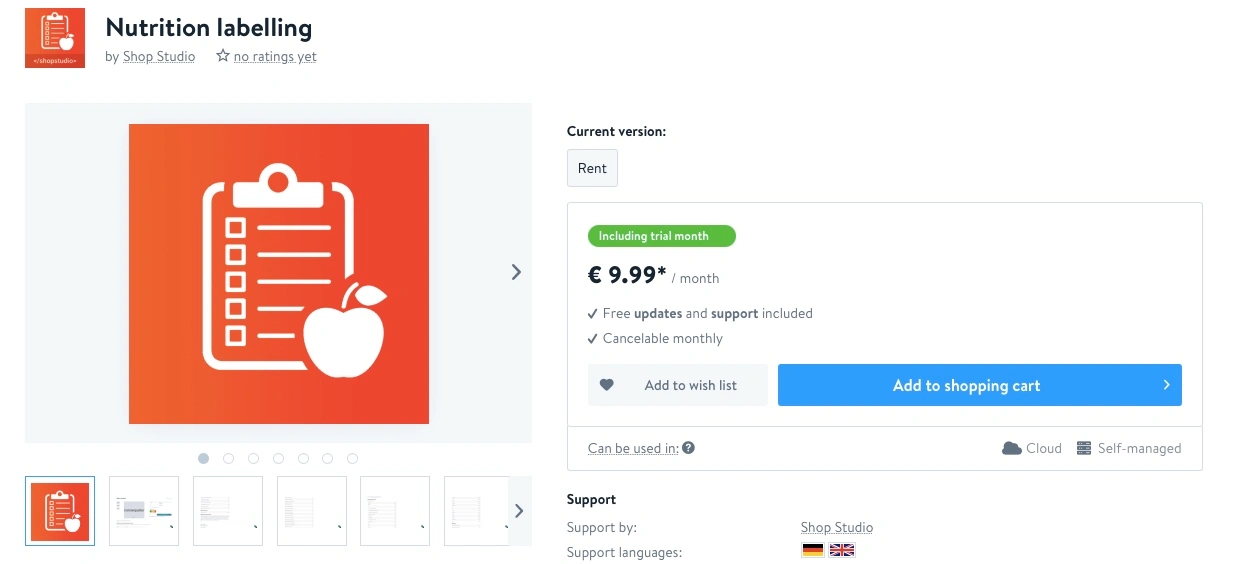Nutritional values in eCommerce stores: Things to keep in mind?
Anyone who sells food in eCommerce faces very special challenges. In regular e-commerce, products are simply advertised and no further details need to be provided. However, in food sales, some details need to be taken into account.
Uniform regulations on food labeling have been in force throughout the EU since December 13, 2016. These regulations can, unfortunately, be supplemented or specified by each EU member state.
This article focuses on the applicable regulations in the EU, because we are located in Germany (and therefore in the EU). - Please inform yourself according to the exact regulations in the country you want to sell your products in.
The purpose of the entire regulations is to be able to determine the exact nature and properties of the food and thus avoid the consumption of possibly incompatible products. After all, many individuals have intolerances, which for some can also lead to serious consequences.
However, before we get to the actual topic of nutritional values, let's first discuss what obligations you face when selling food online in general.
Food designation
The food designation must make it clear what kind of product it is. Many foods also have an official legally designated name. If this is the case, it must be used. You can find this designation in the corresponding product regulation. If no official designation is specified, a description must be clearly formulated in order to determine what kind of food it is.
Mandatory information must be clearly legible
All mandatory information must be legible on your product. This means that the information must be:
- Located in a clearly visible place
- Permanently attached
- Uncovered
In general, therefore, the following applies: The mandatory information must be clearly visible and the eye must not be unnecessarily distracted from you.
Yes, even the size of this information is specified. 1.2 millimeters must be the minimum size of the font. If the area of the product is smaller than 80cm2, the font must have a size of at least 0.9 mm.
The ingredient list
You've probably noticed that you often see a list of ingredients on food products. The manufacturers do this not only out of politeness and pleasure, but because it is mandatory in Germany and the EU.
In principle, all ingredients found in the packaged food must be listed. All ingredients are listed in descending order according to their percentage by weight at the time of production. In some cases, the percentage share must also be indicated. For example, if this ingredient is highlighted in the illustration on the packaging.
Additives and flavors must also be indicated. These are indicated by the class name (e.g. colorant), the designation or the E number.
Allergens
Of course, special allergens must also be labeled in accordance with the purpose of this directive. Allergens correspond to foods that particularly frequently trigger allergies or intolerances, e.g. nuts.
These contents must therefore be specifically indicated in the allergen label and additionally highlighted. Highlighted can be any ingredients with bold, background color, font style or another font.
BBD
The BBD (Best Before Date) indicates how long a food remains suitable for consumption when stored correctly. For foods that spoil quickly, the best before date is replaced by the use by date.
Foodstuffs whose best-before date has passed are usually still suitable for consumption. If the use-by date of the food has passed, it should be disposed of.
Net quantity
By indicating the net quantity, you know how much product is contained in the package. For fruit, this is usually given in grams. For liquid products, it is given in milliliters or liters.
The origin label
Since 01.04.2020, the origin of the main ingredient of a product must be labeled. You can find more detailed information in the Implementing Regulation (EU) 2018/775.
Alcoholic strength
Up to 1.2% vol. No alcohol content must be indicated on the product. For all alcoholic beverages where the alcohol content exceeds this 1.2%, the actual alcohol content must be indicated in percent by volume.
Refined vegetable oils and fats
If refined vegetable oils and fats are used, they must be indicated with their specific vegetable origin. If the oils and fats are listed in a generalized manner in the list of ingredients, a list with the information on the vegetable origin must then be found. In the case of several oils and fats, these must also be listed according to the proportion by weight.
If the oil is hardened, this fact must also be noted.
Caffeinated beverages and foods
All foods with an increased caffeine content must bear the statement "Not suitable for children, pregnant or breastfeeding women". The caffeine content must also be indicated.
However, this rule does not apply to products based on tea or coffee.
Now let's get to the real main topic and that is nutrition labeling.
The Big 7 (or also nutrition labeling)
Nutrition labeling has been mandatory since December 13, 2016. This labeling is usually presented in tabular form.
 That's how a nutrition labeling in your store can look like
That's how a nutrition labeling in your store can look like
To ensure that the contents are optimally comparable, the nutrient contents must always be related to 100 grams or 100 milliliters. In addition, the Big 7 may also be mentioned as a percentage of the specified reference quantity in relation to the 100g or Ml.
Additional information per serving or unit of consumption is also frequently provided. These are voluntary and permissible.
Mandatory information in the nutrition table are the Big 7, this means 7 specifications 🤓:
- Calorific value
- Fat
- Saturated fatty acids
- Carbohydrates
- Sugar
- Protein
- Salt
Other nutritional values as well as vitamins only have to be indicated if they can be seen on the packaging.
Food in eCommerce
If you sell products over the Internet, you must of course take all of these details into account. Already on the website before the purchase you have to provide all these details (except the best before date/ the use by date).

Exceptions to the labeling requirement
In fact, they do exist. Packaged food products that are exempt from mandatory labeling. These include unprocessed monoproducts. Monoproducts are products that consist of only one ingredient or ingredient class. Examples include: Fruit, vegetables, rice, spices or tea.
Natural mineral water, table water and food supplements are subject to separate regulations. Meanwhile, manufacturers of alcoholic beverages have been urged to introduce a nutrition table on a voluntary basis. If this does not work, fixed regulations are to enter here as well.
But there are actually exceptions for products that consist of several ingredients. These are products that are marketed only in small quantities. These include specially made cookies or jams.
The Nutri-Score
Have you ever heard of the Nutri-Score? - This is a simplified representation of nutritional quality. I'm sure you've seen it on products.
Through a guidance system with letters and the traffic light colors, it provides a quick overview of the nutritional properties. Here (logically) the green A stands for the best nutritional quality and the red E for the worst.
 There's for example the Nutri-score of a product from Nesquik
There's for example the Nutri-score of a product from Nesquik
The Nutri-Score helps you to select the product with the best nutritional quality from several products in the same product category (e.g. pizzas). And that without having to read through the entire nutritional value table for ages..
The Nutri-Score can only be used if food also have a nutrition labeling.
Nutritional information
The nutritional claims are voluntary references to the positive nutritional properties of the product. Examples are low fat or 0 calories.
However, this statement can only be used if they also comply with the requirements of the Health Claims Regulation. The individual statements require certain things. For example, products labeled as low-fat may contain a maximum of 3 grams of fat per 100 grams.
The right app for your food shopware store
Of course, it can be time-consuming to manually enter all nutritional values in tabular form under each product. For this reason, there are apps that can make this task a lot easier for you. With the app "Nutrition labelling" from ShopStudio, all you have to do is enter your nutritional values. Select the desired nutritional value from the list and enter the content. The table will appear all by itself. You don't have to type in the ingredients every time, but can simply select them from the list.
 This great app costs only 10€ 🤓
This great app costs only 10€ 🤓
Conclusion
We think this information is relatively easy to handle and should not be a problem for you. The only thing that is certainly a big effort is to find out the obligations. But hey, through our article you have already come a lot further in this point. Certainly, the input of the nutritional values is also a bit time-consuming. But by using a suitable extension, this point is also simplified.
Do you have any other questions or need help with the creation of your eCommerce? - Then contact us. We are happy to help you. 🤓
Ready for your E-commerce success?
As Shopware agency, we help you create your high-turnover & individual online store and promote it with ads and SEO.